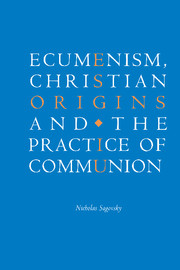Book contents
- Frontmatter
- Contents
- Acknowledgements
- List of abbreviations
- 1 The common life
- 2 Communion: Anglicans, Roman Catholics, and ecumenical consensus
- 3 Plato's vision
- 4 Aristotle's revisionism
- 5 Covenant and community
- 6 Little communities and the Catholic church
- 7 Cappadocian koinonia
- 8 Augustine and the story of communion
- 9 Ecumenism and the practice of communion
- Select biblography
- Index
6 - Little communities and the Catholic church
Published online by Cambridge University Press: 22 September 2009
- Frontmatter
- Contents
- Acknowledgements
- List of abbreviations
- 1 The common life
- 2 Communion: Anglicans, Roman Catholics, and ecumenical consensus
- 3 Plato's vision
- 4 Aristotle's revisionism
- 5 Covenant and community
- 6 Little communities and the Catholic church
- 7 Cappadocian koinonia
- 8 Augustine and the story of communion
- 9 Ecumenism and the practice of communion
- Select biblography
- Index
Summary
THE COMMUNITY OF JESUS
Shortly after the death of Jesus, the Galilean prophet, little communities which looked to him as a living Lord sprang up in Jerusalem, in Damascus, and other cities of the region. These were initially groups of Jews, who, despite his crucifixion, accepted the messianic status of Jesus and the proclamation of his earliest followers that he had been raised from the dead. From the earliest days of the community in Jerusalem, there were members who were Hellenised Jews and before long, in cities like Antioch, Gentiles were included within the groups of those who began to be known as ‘Christians’.
The origins of the form taken by community life in these little groups were complex. Those in the house churches that were ‘the basic cells’ of the growing movement would have been members of local synagogues and Temple-worshippers. Their practice may well have been indebted to particular groups within Judaism like the Jerusalem haberoth: societies of men who banded together in strict keeping of the law, eating meals together in a state of ritual cleanliness. Their practice reflected the climate of thought in which the Essene movement with its strict community life, both concentrated and extended, also flourished.
The first non-Jewish members of Christian groups would probably have been ‘god-fearers’, initially attracted to the life and worship of the Jews.
- Type
- Chapter
- Information
- Ecumenism, Christian Origins and the Practice of Communion , pp. 116 - 145Publisher: Cambridge University PressPrint publication year: 2000



